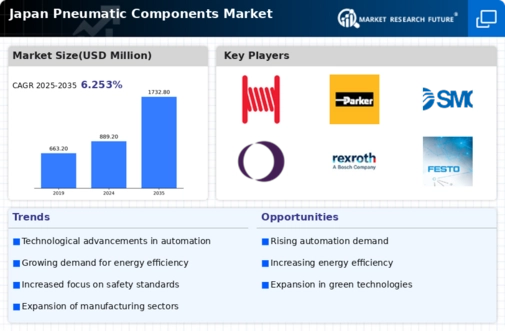Expansion of Manufacturing Sector
Japan's manufacturing sector is undergoing a significant expansion, which is positively impacting the pneumatic components market. The country is known for its advanced manufacturing capabilities, particularly in automotive and electronics industries. In 2025, the manufacturing sector is expected to contribute approximately 20% to the overall GDP, driving the need for efficient pneumatic systems. As manufacturers seek to enhance productivity and reduce downtime, the adoption of pneumatic components is becoming increasingly prevalent. This trend is likely to create new opportunities for suppliers and manufacturers within the pneumatic components market, as they cater to the growing demand for automation and precision in manufacturing processes.
Growing Focus on Safety Standards
Safety standards are becoming increasingly stringent in various industries, which is influencing the pneumatic components market in Japan. Companies are required to comply with enhanced safety regulations to ensure the well-being of their workforce and the integrity of their operations. In 2025, it is projected that compliance-related investments will account for approximately 15% of the total expenditure in the pneumatic components market. This focus on safety is driving the demand for high-quality, reliable pneumatic components that meet regulatory requirements. As a result, manufacturers are likely to prioritize the development of products that not only enhance safety but also improve overall system performance in the pneumatic components market.
Rising Demand for Energy Efficiency
The pneumatic components market in Japan is experiencing a notable surge in demand for energy-efficient solutions. Industries are increasingly adopting pneumatic systems that minimize energy consumption while maximizing output. This shift is driven by stringent regulations aimed at reducing carbon emissions and enhancing operational efficiency. In 2025, the energy-efficient pneumatic components segment is projected to account for approximately 30% of the total market share. Companies are investing in advanced technologies that optimize air usage, thereby reducing operational costs. The focus on energy efficiency not only aligns with environmental goals but also enhances the competitiveness of Japanese manufacturers in the global market. As a result, the pneumatic components market is likely to witness sustained growth fueled by this demand for energy-efficient solutions.
Increased Investment in Infrastructure
The Japanese government is prioritizing infrastructure development, which is expected to significantly influence the pneumatic components market. With plans to invest over $200 billion in infrastructure projects by 2026, there is a growing need for reliable pneumatic systems in construction and transportation sectors. Pneumatic components play a crucial role in various applications, including material handling and automation in construction machinery. This influx of investment is likely to stimulate demand for high-quality pneumatic components, as companies seek to ensure efficiency and safety in their operations. Consequently, the pneumatic components market is poised for growth as infrastructure projects gain momentum.
Technological Innovations in Automation
Technological innovations are reshaping the landscape of the pneumatic components market in Japan. The integration of smart technologies and IoT in pneumatic systems is enhancing their functionality and efficiency. In 2025, it is estimated that around 25% of pneumatic components will incorporate advanced automation features. This trend is driven by the need for real-time monitoring and control in industrial applications. As manufacturers increasingly adopt these technologies, the demand for sophisticated pneumatic components is likely to rise. This shift not only improves operational efficiency but also positions Japanese companies at the forefront of technological advancements in the pneumatic components market.



















Leave a Comment